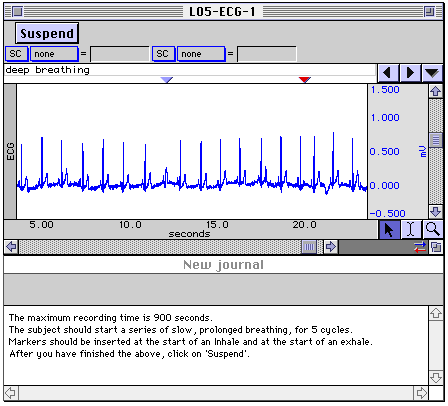Biology

The Biopac Student Lab’s Biology Core Discipline package provides educators with an integrated, flexible teaching system that not only allows the study of the most widely studied responses in Biology, but also an integrated system of hardware, software, and curriculum which increases student engagement and provides extensive instructor support–before, during, and after the lab. The BSL System can record signals from cells, organs, insects, animals and human subjects to facilitate a spectrum of application opportunities. The system has new options for pH, dissolved oxygen and calorimetry (connections and software features). A wide range of lessons covers the cardiovascular, immune, respiratory, pulmonary, metabolic, digestive and nervous systems. User-friendly recording options and analysis tools promote student inquiry and active learning. Employ new software options to develop new lessons specifically tailored to unique course material.
The Biology Core Discipline package’s Cardiovascular Hemodynamics Lessons cover ECG (1-12 lead) and allow students to isolate components of the ECG complex and use the averaging features in the software for further ECG analysis. Use the electronic stethoscope to examine heart sounds and then overlap the data to correlate the sounds with the
mechanical and electrical events of the cardiac cycle. Record arterial blood pressure and record systolic, diastolic, mean, dP/dt max and min, and use the noninvasive Cardiac Output Sensor to record stroke volume and cardiac output.
The Respiratory & Pulmonary Function lessons allow students to record the pattern of breathing as well as perform comprehensive cardiopulmonary tests. Gas Analysis
Students can use the new gas analysis system to monitor expired CO2 and O2 levels for detailed metabolic studies with human and animal subjects.
Features (PDF)
- 53+ lessons targeted for Biology
-
Biology Core package for Windows BSLBIO-W or Mac BSLBIO-M
-
- ECG, EEG, EMG, EOG, EGG
- Respiratory and Pulmonary Function
- Temperature
- pH
- Dissolved O2
- Gas Analysis (O2 and CO2)
- Oxygen uptake
- Blood Pressure
- Cardiac Output (Bioimpedance)
- Stroke Volume
- Tissue Baths
- Force
- Calorimeter Interface
- Pulse
- Autonomic Nervous System
- Nerve Conduction Velocity
- Colorimetry
CURRICULUM
- L11A Reaction Time II - Visual Stimulus
- L12 Pulmonary Function I
- L01 Electromyography I
- L04 Electroencephalography II
- H06 Finger Twitch (SS61L)
- H07 EMG
- H08 Dive Reflex
- L05 Electrocardiography I
- A02 Frog Gastrocnemius
- L09 EDA & Polygraph
- H10 Hemispheric EEG
- H01 12-Lead ECG
- A01 Frog Prep
- H13 Tracking EOG
- H16 Reflexes & Reaction Time
- A05 Visceral Smooth Muscle
- A15 Earthworm Smooth Muscle
- L02 Electromyography II
- H06 Finger Twitch (SS12LA)
- H27 Facial EMG
- H34 Electrogastrogram
- H36 Muscular Biofeedback
- A04 Frog Heart - Cardiac Rate & Contractility
- A08 Earthworm Action Potential
- A11 Resting Potential - Crayfish Muscle
- L20 Spinal Cord Reflexes
- A17 Frog Heart Intracellular Action Potentials
- L06 Electrocardiography II
- H04 Blood Pressure
- H05 WAnT Wingate Test
- H23 Signal Averaging ECG
- H32 Heart Rate Variability
- A07 Fish Respiration & Q10
- L14 Biofeedback
- A03 Frog Sciatic Nerve
- A06 Cockroach Ventral Nerve AP
- A09 Turtle Heart
- H15 Fixation II EOG
- L03 Electroencephalography I
- H03 Nerve Conduction - MP36/35
- H03 Nerve Conduction - MP30
- H11 Mirror Test EDA
- H12 Saccades EOG
- H14 Fixation I EOG
- H24 Habituation
- H02 Compartmental Modeling
- H20 Filtering
- H33 FFT Fast Fourier
- A14 CPG Hornworm
- L07 ECG & Pulse
- L15 Aerobic Exercise Physiology
- L08 Respiratory Cycle I
- L10 Electrooculogram I
- L13 Pulmonary Function II
- L16 Blood Pressure
- L17 Heart Sounds
- L11 Reaction Time I - Auditory Stimulus
Stay Connected